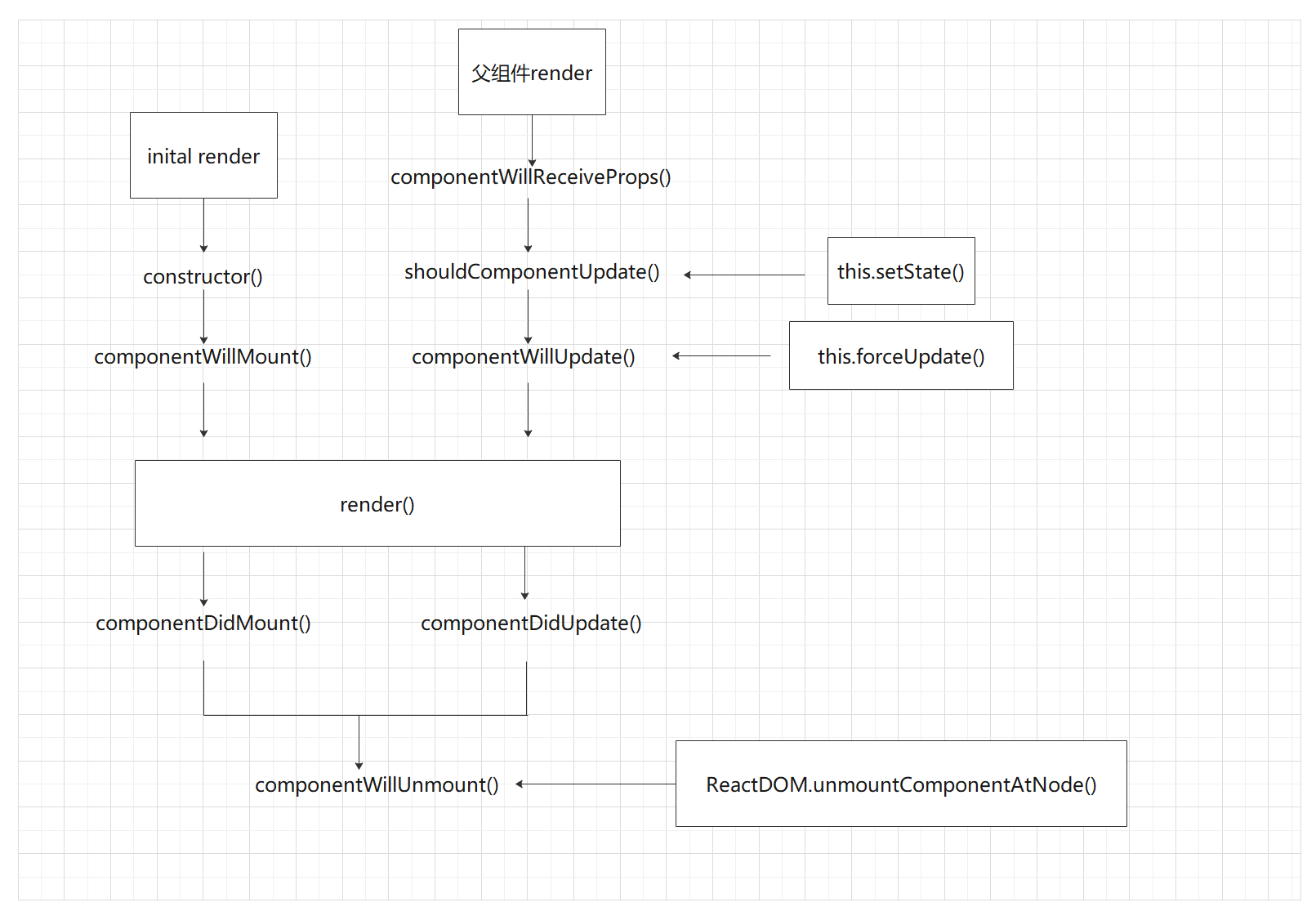React生命周期函数
相关函数
| 方法 | 调用时机 |
| constructor(props, context) | 构造函数,在创建组件的时候调用一次。 |
| void componentWillMount() | 在组件挂载之前调用一次。如果在这个函数里面调用setState,本次的render函数可以看到更新后的state,并且只渲染一次。 |
| void componentDidMount() | 在组件挂载之后调用一次。这个时候,子组件也都挂载好了,可以在这里使用refs。 |
| void componentWillReceiveProps(nextProps) | props是父组件传递给子组件的。父组件发生render的时候子组件就会调用componentWillReceiveProps(不管props有没有更新,也不管父子组件之间有没有数据交换)。 |
| bool shouldComponentUpdate(nextProps, nextState) | 组件挂载之后,每次调用setState后都会调用shouldComponentUpdate判断是否需要重新渲染组件。默认返回true,需要重新render。在比较复杂的应用里,有一些数据的改变并不影响界面展示,可以在这里做判断,优化渲染效率。 |
| void componentWillUpdate(nextProps, nextState) | shouldComponentUpdate返回true或者调用forceUpdate之后,componentWillUpdate会被调用。 |
| void componentDidUpdate() | 除了首次render之后调用componentDidMount,其它render结束之后都是调用componentDidUpdate。 |
| ReactElement render() | render是一个React组件所必不可少的核心函数(上面的其它函数都不是必须的)。记住,不要在render里面修改state。 |
| void componentWillUnmount() | 组件被卸载的时候调用。一般在componentDidMount里面注册的事件需要在这里删除。 |
componentWillMount、componentDidMount和componentWillUpdate、componentDidUpdate可以对应起来。区别在于,前者只有在挂载的时候会被调用;而后者在以后的每次更新渲染之后都会被调用。
更新方式
在react中,触发render的有4条路径。
以下假设shouldComponentUpdate都是按照默认返回true的方式。
- 首次渲染Initial Render
- 调用this.setState (并不是一次setState会触发一次render,React可能会合并操作,再一次性进行render)
- 父组件发生更新(一般就是props发生改变,但是就算props没有改变或者父子组件之间没有数据交换也会触发render)
- 调用this.forceUpdate

componentWillMount与componentDidMount对比
1、componentWillMount 将要装载,在render之前调用;
componentDidMount,(装载完成),在render之后调用
2、componentWillMount 每一个组件render之前立即调用;
componentDidMount render之后并不会立即调用,而是所有的子组件都render完之后才可以调用
3、componentWillMount 可以在服务端被调用,也可以在浏览器端被调用;
componentDidMount 只能在浏览器端被调用,在服务器端使用react的时候不会被调用
注意,如果在shouldComponentUpdate里面返回false可以提前退出更新路径。
componentDidUpdate与componentWillReceiveProps对比
1、componentWillReceiveProps在组件接受新的props之前触发;
componentDidUpdate在组件接受新的props之后触发
2、componentWillReceiveProps更新状态是同步的
componentDidUpdate更新状态是异步的
这点区别非常重要,也是componentWillReceiveProps生命周期被废弃的重要原因(可能导致某些问题), 所以推荐使用componentDidUpdate
React组件生命周期的测试
class LifeCycle extends React.Component {constructor(props) {super(props);alert("LifeCycle constructor");this.state = {str: "hello"};}componentWillMount() {alert("componentWillMount");}componentDidMount() {alert("componentDidMount");}componentWillReceiveProps(nextProps) {alert("componentWillReceiveProps");alert(nextProps.num);}shouldComponentUpdate(nextProps, nextState) {alert("shouldComponentUpdate");return true; // 记得要返回true}componentWillUpdate(nextProps, nextState) {alert("componentWillUpdate");}componentDidUpdate() {alert("componentDidUpdate");}componentWillUnmount() {alert("componentWillUnmount");}setTheState() {let s = "hello";if (this.state.str === s) {s = "HELLO";}this.setState({str: s});}forceItUpdate() {this.forceUpdate();}render() {alert("render()");return (<div><span>{"Props:"}<h2>{parseInt(this.props.num)}</h2></span><br/><span>{"State:"}<h2>{this.state.str}</h2></span></div>);}}class Container extends React.Component {constructor(props) {super(props);this.state = {num: Math.random() * 100};}propsChange() {this.setState({num: Math.random() * 100});}setLifeCycleState() {this.refs.rLifeCycle.setTheState();}forceLifeCycleUpdate() {this.refs.rLifeCycle.forceItUpdate();}unmountLifeCycle() {// 这里卸载父组件也会导致卸载子组件ReactDOM.unmountComponentAtNode(document.getElementById("root"));}parentForceUpdate() {this.forceUpdate();}render() {return (<div><button className="propsChange"onClick={this.propsChange.bind(this)}>propsChange</button><button className="setState"onClick={this.setLifeCycleState.bind(this)}>setState</button><button className="forceUpdate"onClick={this.forceLifeCycleUpdate.bind(this)}>forceUpdate</button><button className="unmount"onClick={this.unmountLifeCycle.bind(this)}>unmount</button><button butto className="parentForceUpdateWithoutChange"onClick={this.parentForceUpdate.bind(this)}>parentForceUpdateWithoutChange</button><LifeCycle ref="rLifeCycle" num={this.state.num}></LifeCycle></div>);}}ReactDOM.render(<Container></Container>,document.getElementById('root'));
componentWillMount 和 componentDidMount 那个更适合请求数据?
componentWillMount
这个方法正确调用的时候是在component第一次render之前, 所以第一眼看上去觉得就应该在这里去fetch datas.
但是这里有个问题, 在异步请求数据中这一次返回的是空数据, 因为在’render’之前不会返回数据。所以在渲染的时候没有办法得到数据,也不能在componentWillMount中返回一个Promise(因为Promise的特性之一就是状态不可变),或者用setTimeout也是不适合的。正确的处理方式就不要在这里请求数据,而是让组件的状态在这里正确的初始化.
顺便说一句在es6中,使用extend component的方式里的constructor函数和componentWillMount是通用的作用,所以你在构造函数里初始化了组件的状态就不必在WillMount做重复的事情了.
componentDidMount
componentDidMount是在render之后调用一次,component已经初始化完成了。
在生产时,componentDidMount生命周期函数是最好的时间去请求数据,其中最重要的原因就是componentDidMount一定是在组件初始化完成之后才会请求数据,因此不会报什么警告或者错误,我们正常请求数据完成之后一般都会setState.
参考:



































还没有评论,来说两句吧...